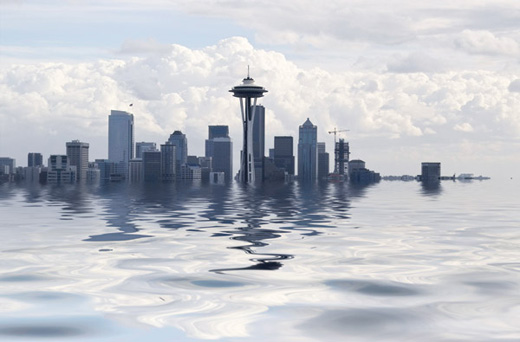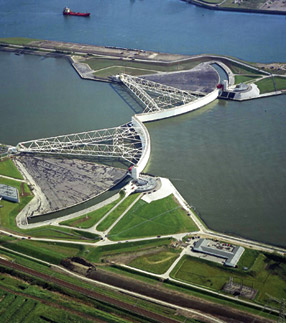Time & Tide
BY DAVID ZAX
Rising sea levels wait for no man. Will we be ready in time?
Whether or not the end-of-year talks in Copenhagen yield bold global action on carbon emissions, we are already living in a warming world. Even if all burning of fossil fuels were to cease tomorrow, the build-up of greenhouse gases in the Earth’s atmosphere is severe enough that by 2100, we would still be looking at a world at least several degrees warmer than during the preindustrial era. That warming brings with it certain hazards – droughts, the spread of infectious diseases, the extinction of species. But there’s one hazard in particular that will require an engineering response: the rise of sea levels.
Seas are expected to rise by at least a few inches by the end of this century, and possibly by as much as a meter – principally owing to the thermal expansion of the ocean but also because of melting ice sheets in Antarctica and Greenland. A few inches may not sound like much, but it’s enough to threaten a low-lying coast and is particularly troubling to regions within reach of a hurricane. What’s more, when you consider that about half of the population of the United States lives near the coast, even a modest amount of sea-level rise radically alters the calculus of flood protection along thousands of miles of shoreline.
“I have never addressed a larger challenge in my life,” says Robert Bea, a professor of civil and environmental engineering at the University of California, Berkeley. “This one, it just blows my mind.” Bea has studied both the New Orleans and Sacramento areas and notes frightening similarities. “I hope Arnold Schwarzenegger knows how to swim,” he says.
Dire warnings of coastal flooding have led to some elaborate proposals. Recently, William Merrell, a marine sciences professor at Texas A&M, Galveston, put forward “the Ike Dike,” named after the devastating hurricane that in 2008 struck the barrier island where his school is located. Merrell, who serves as chair and principal scientist of the Institute for Oceans and Coasts, envisions greatly extending the current sea wall, adding gates across vulnerable roads, and creating another barrier along the nearby peninsula – all of which would result in what he calls a defensive “coastal spine” stretching some 55 miles. The project could take more than a generation to complete, at a cost Merrell has pegged at $2 billion to $3 billion.
Cost is just one of the hurdles: Some critics worry that the new barrier would interrupt shipping and damage the fragile coastal ecosystem. But Merrell, who has been a frequent visitor to the Netherlands, which has coped with flood prevention for centuries, believes his plan is viable. His vision for the Ike Dike involves large gates that would remain open most of the time to allow navigation and ecosystem protection. “It’s not rocket science; it’s just using big barriers to protect us from the surge,” he says.
Engineers elsewhere are considering projects of even grander scale. New York City lies exposed from multiple directions. So a group of academics at State University of New York-Stony Brook has proposed a series of flood barriers: one by the Verrazano-Narrows Bridge to the south, another to the city’s east, where the East River meets the Long Island Sound, and two at other strategic spots. New York City officials are nonplused by the $9 billion price tag, but Douglas Hill, one of the engineers in the Stony Brook group, says it would be worth every penny. New Orleans suffered an estimated $200 billion in damage from Katrina; New York, he points out, has 10 times more insured property value. He invokes Max Mayfield, former director of the National Hurricane Center, who, in 2006 congressional testimony, stated, “It is not a question of if a major hurricane will strike the New York area, but when.” In March, the American Society of Civil Engineers convened a conference of some 100 engineers and scientists, including the Stony Brook group, Dutch and British engineering firms, and the U.S. Army Corps of Engineers, to evaluate the concept of storm surge barriers.
“On Our Radar”
For its part, the Army Corps is taking global warming and the resulting sea-level rise into account as it plans civil works projects in coastal areas. The world’s biggest public engineering agency, the corps has a major role in planning and building many flood-control and coastal protection schemes. In July, the agency issued new guidance warning of a “continued or accelerated rise in global mean sea level,” which “must be considered in all phases of Civil Works programs.” Project engineers are told to refer both to estimates by the Intergovernmental Panel on Climate Change and to the upper range of projections in a 1987 National Research Council study. These latter estimates of sea-level rise are high enough to take into account “the rapid loss of ice from Antarctica and Greenland.” Rising sea levels are not a new concern for the corps, which helped fund the original NRC study. “It’s always been on our radar,” says Kathleen White, a hydraulic engineer and a leading corps expert on climate change.
Both the corps and the National Oceanic and Atmospheric Administration are involved in ongoing research. NOAA is seeking more precise regional sea-level rise information, using both modeling and observation. NOAA-funded university research is looking particularly at the northeastern Gulf of Mexico region. The Army Corps’s Kevin Knuuti, principal author of his agency’s new guidelines, says interest in sea-level rise seems to have grown across much of the government as part of a surge in climate research.
Yet to some experts, the research and planning to date are inadequate to the task of protecting the lives and livelihoods of many millions, both at home and overseas. If New York and New Orleans are threatened, so are London, Shanghai, Miami, Mumbai, Cairo, Amsterdam, and Tokyo. “It’s a kind of oozing hazard, a slow, creeping hazard,” says Ed Link, a senior research engineer in the department of civil and environmental engineering at the University of Maryland. “And that’s part of the problem of getting people serious about it.”
A New Curriculum Needed
Link has a better grasp than most of possible doomsday scenarios, having led a recent forensic analysis of what went wrong with New Orleans’s levees. For most regions, however, the solutions required are less dramatic than superlevees, yet equally important. Civil engineers have to ponder whether buildings will encounter greater flooding in the face of sea-level rise. If so, can they be elevated or retrofitted, or must they be abandoned? And what of infrastructure? Link singles out water treatment and storm drainage facilities as particularly vulnerable elements: “We don’t have our arms around how serious that might be and what we would have to do to mitigate those kinds of impacts,” he says.
Beyond research, universities have been slow to embrace the challenge of training engineers capable of tackling sea-level rise, says Ricardo Alvarez, a research fellow at the Florida Center for Environmental Studies at Florida Atlantic University. “You don’t have a course that says ‘Sea Level Rise 101,’ for example. And I think we should. I think we need to.” For such a curriculum change to become widespread, however, universities need to break down barriers between disciplines, notes Paul Kirshen, a climate change specialist, who recently left Tufts University to join the nonprofit consulting firm Battelle. “The issue is so complex,” he says. “It involves economics, engineering, environmental science, and policy, and sociology – and I probably forgot a few, because water cuts across all aspects of life.” A few years ago, Kirshen succeeded in getting Tufts to launch an M.S. and Ph.D. certificate program, Water: Systems, Science, and Society, which takes an interdisciplinary approach. Richard Vogel, who now heads the flourishing program, boasts that it involves every graduate school at Tufts except the dental school.
Bea, of Berkeley, says one discipline that shouldn’t be left out of sea-level studies is political science. A key problem confronting engineers concerned with sea-level rise is simply getting people – and their government representatives – to listen. “I don’t think we have a technological challenge of being able to do something,” agrees Maryland’s Ed Link. It’s more a challenge of “getting the political will to do something about infrastructure along the coastline” – even if a serious threat is decades away. Coastal areas continue to draw new residents seeking the sensation of ‘Wow, I can see the ocean from there,’” says Link. “We need to turn that around and get people to realize the ocean can see them from there, too!”
David Zax is a freelance writer specializing in science.
Category: Features


